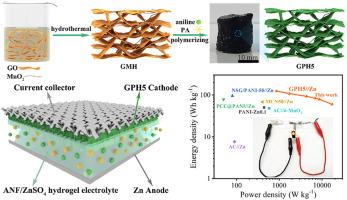结合芳纶纳米纤维水凝胶电解质的受限模板合成石墨烯/聚苯胺水凝胶阴极制备高性能锌离子杂化超级电容器
IF 7.9
2区 工程技术
Q1 CHEMISTRY, PHYSICAL
引用次数: 0
摘要
锌离子混合超级电容器(zihc)因其经济性、电池性能和环境友好性而备受关注。然而,它们的低比容量和不可逆枝晶生长阻碍了它们的实际应用。本文采用石墨烯/二氧化锰水凝胶和溶剂交换/浸泡法制备了石墨烯/聚苯胺水凝胶(GPH5)阴极和芳纶纳米纤维/ZnSO4 (ANF/ZnSO4)水凝胶电解质。以二氧化锰为牺牲模板的受限模板策略有效地避免了苯胺在石墨烯网络中的不均匀吸附。GPH5阴极具有丰富的电化学活性位点和强大的3D交联网络,聚苯胺纳米纤维和纳米毡紧密锚定在石墨烯片上,具有良好的比容量达到456.7 F g−1,高倍率性能达到84.5% (1 - 20 A g−1)。制备的ANF/ZnSO4水凝胶电解质具有较高的离子电导率(3.02 S m−1)和机械强度,提高了离子传输效率。因此,组装的ZHSCs有效地抑制了Zn枝晶的生长,并提供了出色的比容量(311.3 F g−1或147.0 mAh g−1在1 A g−1),高能量密度(125.0 Wh kg−1)和优异的功率密度(达到17000 W kg−1)。结果表明,由GPH5阴极和ANF/ZnSO4水凝胶电解质组成的zhsc在新型电化学存储系统中具有广阔的应用前景。本文章由计算机程序翻译,如有差异,请以英文原文为准。

Confined templated-synthesized graphene/polyaniline hydrogel cathode integrated with aramid nanofiber hydrogel electrolyte toward high-performance Zn-ion hybrid supercapacitors
Zn-ion hybrid supercapacitors (ZIHCs) have attracted significant attention because of their affordability, battery-like capability and environment friendliness. However, their low specific capacity and irreversible dendrite growth have hindered the practical applications. Herein, graphene/polyaniline hydrogel (GPH5) cathode and aramid nanofiber/ZnSO4 (ANF/ZnSO4) hydrogel electrolyte are respectively fabricated via confined template polymerization in graphene/MnO2 hydrogel and solvent exchange/immersing process in 2 M ZnSO4 solution. The confined template strategy using MnO2 as sacrificial template effectively avoids uneven aniline adsorption in graphene networks. The resulting GPH5 cathode presents rich electrochemical active sites and strong 3D crosslinked network with polyaniline nanofibers and nanofelts tightly anchoring on graphene sheets, achieving favorable specific capacity achieving 456.7 F g−1 and high rate performance reaching even 84.5 % (1–20 A g−1). As-prepared ANF/ZnSO4 hydrogel electrolyte exhibits high ionic conductivity (3.02 S m−1) and mechanical strength, enhancing the ion transport efficiency. Consequently, assembled ZHSCs efficiently suppress Zn dendrite growth and deliver outstanding specific capacity (311.3 F g−1 or 147.0 mAh g−1 at 1 A g−1), high energy density (125.0 Wh kg−1) and excellent power density (reaching 17000 W kg−1). The results reveal ZHSCs consisting of GPH5 cathode and ANF/ZnSO4 hydrogel electrolyte are promising in new electrochemical storage systems.
求助全文
通过发布文献求助,成功后即可免费获取论文全文。
去求助
来源期刊

Journal of Power Sources
工程技术-电化学
CiteScore
16.40
自引率
6.50%
发文量
1249
审稿时长
36 days
期刊介绍:
The Journal of Power Sources is a publication catering to researchers and technologists interested in various aspects of the science, technology, and applications of electrochemical power sources. It covers original research and reviews on primary and secondary batteries, fuel cells, supercapacitors, and photo-electrochemical cells.
Topics considered include the research, development and applications of nanomaterials and novel componentry for these devices. Examples of applications of these electrochemical power sources include:
• Portable electronics
• Electric and Hybrid Electric Vehicles
• Uninterruptible Power Supply (UPS) systems
• Storage of renewable energy
• Satellites and deep space probes
• Boats and ships, drones and aircrafts
• Wearable energy storage systems
 求助内容:
求助内容: 应助结果提醒方式:
应助结果提醒方式:


